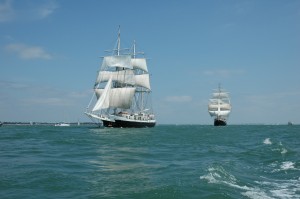
The JST takes both disabled and able-bodied men and women to sea, to not only teach them how to crew a tall ship, but to promote equality, sharing, and to celebrate our individual differences by working together to achieve greater things.
Since the JST was established in 1978 over 36,000 people have sailed with us. Of these approximately 12,500 people were disabled and 4,500 wheelchair users.
A trip with the JST changes the lives of disabled people as they suddenly realise that, far from being unable to join in with everybody else, they can do everything. I’ve seen people come home from a voyage and seem five feet taller – the experience has completely changed the way they see themselves.
Alan Titchmarsh, Vice Patron
Who Sails?
Anyone over the age of 16 can sail with us and we take people from all over the UK and further afield. We aim to take an equal mix of able-bodied and physically disabled crew on each trip with a maximum of 40 people on each voyage. We strive to achieve integration on other levels such as age, background, religion, culture and gender.
 Aboard our ships every crew member has a vital role to play irrespective of ability, disability, age, or gender. The success of each voyage depends on teamwork and working to the best of individuals’ strengths, not weaknesses. Crewing a tall ship can be a challenge for anyone, at the Jubilee Sailing Trust we prove that with teamwork and understanding this challenge can be met.
Aboard our ships every crew member has a vital role to play irrespective of ability, disability, age, or gender. The success of each voyage depends on teamwork and working to the best of individuals’ strengths, not weaknesses. Crewing a tall ship can be a challenge for anyone, at the Jubilee Sailing Trust we prove that with teamwork and understanding this challenge can be met.
16-25 year olds can choose to take part in our Youth Leadership @ Sea scheme which is designed to increase confidence, self-esteem, leadership skills and diversity awareness. We also work with Armed Forces regiments and charities to offer a rehabilitation programme, where people with life-altering injuries or experiences can gain a new sense of their abilities within their changed circumstances.
Lord Nelson and Tenacious are the only two tall ships in the world that have been purpose built to enable people of all physical and sensory abilities to take an active role in sailing. The features on board include:
- Signs in Braille
- Braille book
- Lifts between decks for wheel chair users or those with limited mobility
- Vibrator pads fitted to the bunks to alert people who are deaf or hearing impaired in the event of an emergency
- Power assisted steering or joystick assisted steering to enable those with limited mobility to easily manoeuvre the ship
- An induction loop in the mess room to assist those with hearing impairments during briefing sessions
- Wide aisles below decks
- Low level fittings
- Guidance track on deck to help blind and visually impaired crew to navigate their way around
- Speaking compass to enable blind or visually impaired voyage crew to steer the ship
- ‘Unwin’ fixing points throughout for wheelchairs in rough weather
- Bathrooms include full facilities for all physical abilities
Why funding is required?
We subsidise every voyage place by 30% – 50% to ensure they are affordable and accessible to all. Additional bursaries are available where further financial assistance is required. The total cost of operating our tall ships is in the region of £2,900,000 per annum. Approximately 50% of these costs are covered by income from voyage fees. The balance of running and repair costs has to be raised via events, individual donations and grants from Trusts and Foundations. Our ongoing costs include sails and rigging, navigational equipment, berthing and services, medical supplies, victuals, bedding, clothing and laundry, fuel, lifesaving equipment, communication, chandlery and crew costs.





